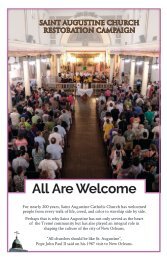Saint Augustine Church Restoration Campaign _ Sponsorship
St. Augustine Church was built in 1841, making it 178 years old this year. The structure is so compromised that it leaves her vulnerable to storms, decay, and other conditions that may result in the closing of her doors forever and is in dire need of major renovations. The St. Augustine Church Restoration Campaign is the first Church’s first-ever effort to restore the church and rectory buildings. St. Augustine Church is known for its’ congregation of all races, Free People of Color, slaves, whites, Haitians, Cubans, Italians, Germans, etc. from its inception in 1841, till today and as the nation’s oldest black Catholic parish, it is part of the permanent exhibits in the Smithsonian’s new National Museum of African American History and Culture in Washington, D.C. Considered the oldest black neighborhood in America, and the oldest African American Church in the country, it was home to the first civil rights movement, the first black daily newspaper, black businesses and was deeply rooted in the development of the music culture and parading history of New Orleans which came out of Tremé.
St. Augustine Church was built in 1841, making it 178 years old this year. The structure is so compromised that it leaves her vulnerable to storms, decay, and other conditions that may result in the closing of her doors forever and is in dire need of major renovations. The St. Augustine Church Restoration Campaign is the first Church’s first-ever effort to restore the church and rectory buildings.
St. Augustine Church is known for its’ congregation of all races, Free People of Color, slaves, whites, Haitians, Cubans, Italians, Germans, etc. from its inception in 1841, till today and as the nation’s oldest black Catholic parish, it is part of the permanent exhibits in the Smithsonian’s new National Museum of African American History and Culture in Washington, D.C.
Considered the oldest black neighborhood in America, and the oldest African American Church in the country, it was home to the first civil rights movement, the first black daily newspaper, black businesses and was deeply rooted in the development of the music culture and parading history of New Orleans which came out of Tremé.
Create successful ePaper yourself
Turn your PDF publications into a flip-book with our unique Google optimized e-Paper software.
What is so unique about this church?<br />
St. <strong>Augustine</strong> <strong>Church</strong> was built in 1841, making it 177 years old this year.<br />
The structure is so compromised that it leaves her vulnerable to storms, decay,<br />
and other conditions that may result in the closing of her doors forever and is in<br />
dire need of major renovations. Phase I focuses on the restoration of the <strong>Church</strong><br />
and rectory at a cost of $2.5 million dollars.<br />
An inscription in French above the altar translates<br />
“If you know the gift of God”<br />
● St. <strong>Augustine</strong> <strong>Church</strong> in Tremé is a<br />
historic treasure, a religious haven,<br />
a testament to the love of God and<br />
community, and a monument to the<br />
history and culture of New Orleans;<br />
the African American culture of<br />
the United States, and the African<br />
American and Creole culture of<br />
Tremé.<br />
● St. <strong>Augustine</strong> <strong>Church</strong> has been a<br />
spiritual center since 1841, a place of<br />
history, religion and brotherhood;<br />
known for its’ congregation of all<br />
races, Free People of Color, slaves,<br />
whites, Haitians, Cubans, Italians,<br />
Germans, etc. from its inception<br />
in 1841, till today. Kneeling at the<br />
altar, praying side by side.<br />
● Henriette Delille took her vows at<br />
the altar and served the community<br />
at St. <strong>Augustine</strong> <strong>Church</strong>, and was<br />
one of the three women who started<br />
the Sisters of the Holy Family in<br />
1842. Henriette Delille is Venerable,<br />
awaiting <strong>Saint</strong>hood and could be the<br />
first African American <strong>Saint</strong>. She<br />
started the first school to educate<br />
slave children, women and men;<br />
established a home for aged and was<br />
a loving mother to the community<br />
through her service at St. <strong>Augustine</strong><br />
<strong>Church</strong>.<br />
● Considered the oldest black<br />
neighborhood in America, and the<br />
oldest African American <strong>Church</strong><br />
in the country, it was home to the<br />
first civil rights movement, the<br />
first black daily newspaper, black<br />
businesses and was deeply rooted<br />
in the development of the music<br />
culture and parading history of New<br />
Orleans which came out of Tremé.<br />
● St. <strong>Augustine</strong> <strong>Church</strong>, as the nation’s<br />
oldest black Catholic parish, is part<br />
of the permanent exhibits in the<br />
Smithsonian’s new National Museum<br />
of African American History and<br />
Culture in Washington, D.C.<br />
Whether it is the tenderness and deep sense of caring of the church<br />
community, the exquisite, moving music sung by choir, the striking mix of<br />
the congregation, folks of all colors, means and ages; the vibrant brass bands<br />
that celebrate on special occasions, and the words of wisdom from our priest;<br />
intertwined, the mass at St. <strong>Augustine</strong> is known to move new visitors to tears.<br />
Once renovated St. <strong>Augustine</strong> <strong>Church</strong> will once again become the center<br />
of the community; it will invite the community old and new to experience its<br />
ministries, to establish everyone’s living relationship with God. It will sponsor<br />
community programs, support groups, classes, counseling services, after school<br />
activities, CYO, music lessons and other neighborhood services. It will provide<br />
educational opportunities for the church, the residents, its religious staff and<br />
the archdiocese.<br />
We believe that losing <strong>Saint</strong> <strong>Augustine</strong> <strong>Church</strong> would prove more damaging<br />
that just losing a historic or sacred place. It would be losing a testament to unity,<br />
love, inclusion and brotherhood.<br />
“If you know the gift of God”





